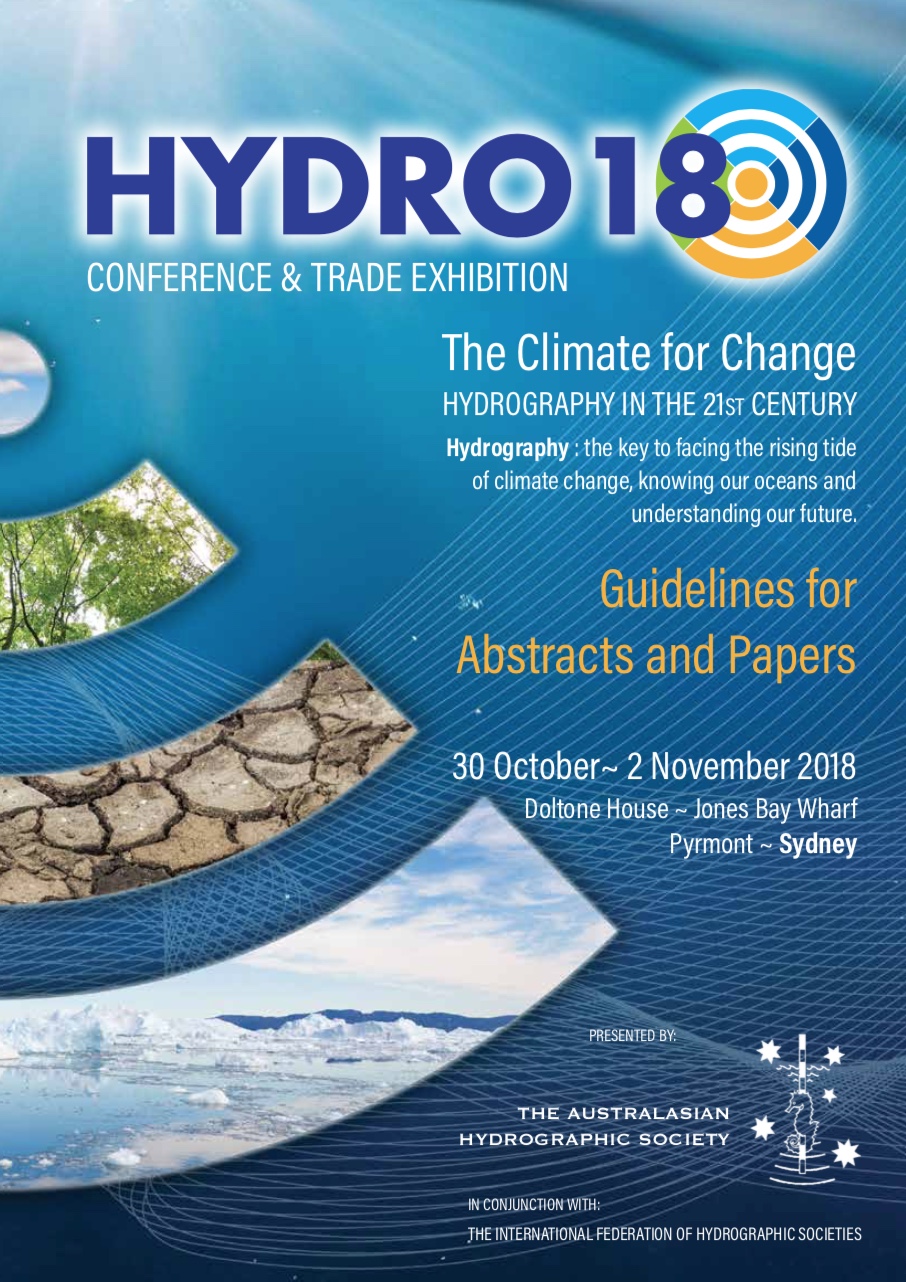

30 October - 1 November 2018
Doltone House, Jones Bay Wharf
Pyrmont, Sydney
Australia





HYDRO18, with its theme of ‘The Climate for Change – Hydrography in the 21st Century’ will allow delegates and the hydrographic profession to consider how best to utilise the science of Hydrography in the future to adapt to climate change, sustainable resource usage and renewable energy requirements. Along with its sub-theme, ‘Hydrography - the key to facing the rising tide of climate change, knowing our oceans and understanding our future,’ the Conference will also highlight that Hydrography is the key to facing the rising tide of climate change, knowing our oceans and understanding our future.
Hydrography is fundamental to coping with the effects of climate change, sea level rise, and the increasing pressures for sustainable resources and renewable energy through tidal and wind power. It is also vital for economic development, especially that of maritime and small island states. However, the e ect of Hydrography is not fully understood or properly recognized for its direct and indirect links to global economic wellbeing and nations that rely on maritime trade, maritime protection and resource management. The recognition of the Blue Economy is emerging, and those nations that grasp the importance of this concept and its associated economic significance through hydrography will reap considerable benefits.
The science of Hydrography and its ability and potential to deal with the effects of climate change, sea level rise, its importance to the global economy (including resource sustainability, renewable energy and environmental protection) is not generally understood. This situation needs to be changed urgently noting the changing global geo-political situation. The concept of the Blue Economy must be spread within the Asia-Pacific region, especially amongst the small island states that have yet to reach their potential. The theme of the Conference and its sub-theme, seeks to create debate and discussion as to how Hydrography can be harnessed to its full potential. The Conference will bring presenters with knowledge and experience in many areas related to Hydrography, the Blue Economy, related industry and the sciences. All of these areas will be of interest to delegates, and for them to take away the message for opportunities and challenges through Hydrography within government, private industry and academia.
With a keen eye on our changing world and noting these opportunities and challenges, the theme of HYDRO18 has been selected to focus on and address emerging issues influencing us today and in the future.
The Organising Committee invites prospective participants to submit abstracts and papers, which comply with the ‘Guidelines for Abstracts and Papers’ for oral presentations. Selected presenters will be encouraged to prepare and provide a full conference paper - these papers will be considered for inclusion in the Conference Proceedings. Papers are sought to reflect the conference theme and original papers will be selected on merit. Those selected for inclusion in the program will best reflect the theme and sub-themes, plus allow an overall balance to the final program.
All presenting authors must be registrants at the Conference. Please register your interest in providing a conference paper and/or presentation with Conference Solutions as soon as possible. Abstracts complying with the guidelines must be submitted to Conference Solutions by email by 31 May 2018 01 July 2018.
A list is provided below related to the theme and possible sub-themes that authors may wish to present. All authors are expected to provide permission for their papers and presentations to be published in the HYDRO18 Proceedings, which will be available in either hard or soft copy. It is not intended to offer refereeing of any paper, however papers will be checked for relevance and appropriateness. Authors will be free to submit their paper to appropriate journals for refereed publication.
Some suggested subjects are shown below, which may be used by authors and presenters.
Please click on subjects to expand the corresponding sections.
| Nautical Charting |
| Coastal Zone Management |
| Industrial Offshore Surveying/Offshore Construction Surveying |
| Military Hydrography & military hydrographic requirements |
| Current trends & innovative techniques in Hydrography and associated technology |
| Remote sensing – satellite bathymetry |
| Resource surveys |
| Surveying using Unmanned Underwater Vehicles (UUVs) & Autonomous Underwater Vehicles (AUVs) |
| Surveying in remote regions |
| Contract hydrographic surveying |
| Data acquisition & management e.g. crowd-sourcing |
| The changing imperatives – sustainable resources, renewable energy, climate change and sea level rise |
| How can Hydrography help? |
| Current trends |
| Climate change |
| Trends in the sciences |
| Impact of climate change, sea level change and the role of Hydrography |
| Managing the coastal strip |
| Marine pollution control: • Shipping • Land run-off • Dredging |
| Surveying for the environment |
| Trends |
| Innovation |
| Industry perspectives |
| Urban trends |
| Coastal infrastructure |
| Leisure |
| Sea level rise and inundation |
| Role of international & national hydrographic and maritime agencies |
| Standards in hydrographic surveying |
| Impact of policy on industry and environment |
| Improved policy delivery |
| Trends |
| Strategic planning for Hydrography and maritime industries |
| Research commercialization & Business development |
| Updates on the activities of these organisations |
| Their role in supporting Hydrography and capacity building |
| The importance and effectiveness, or not, of such organisations |
| Meeting the critical global shortfall of hydrographic surveyors |
| Emerging requirements for Hydrography, and qualified hydrographic professionals |
| Meeting international and national requirements |
| Initiatives |
| Educational and training standards |
| What is the ‘Blue Economy’? |
| Importance to national and regional economies |
| Who is affected by the ‘Blue Economy’, and how? |
| Cruise shipping |
| General Cargo |
| Petroleum, oil and gas |
| Specialist cargo, including dangerous cargoes |
| Trends |
| Update on current exploration |
| Military geospatial information |
| Rapid environmental assessment |
| Remote sensing of maritime areas |
| Australia on the map |
| Maritime history in the Asia-Pacific region |
| New maritime history discoveries and theories |
| Maritime spatial history |
| Significant surveyors and surveys |
| Eco-tourism |
| Boutique cruise shipping – General, Tropics, Arctic and Antarctic |
| Consumer requirement for pristine destinations |
| Emerging trends in port and harbor infrastructure design |
| Changes in ship technology and design |
| Development of new ports and harbours |
| 01 March | Early-bird registration opens and call for abstracts and papers |
| Abstract submissions close. Abstracts reviewed and advice given to authors | |
| 1 July | Papers Submission Open (papers may be submitted prior to this date) |
| 15 August | Papers Reviewed |
| 02 September | Papers Accepted and authors advised |
| 30 October | HYDRO18 opens |
The abstract should be a precis of the material to be presented and must be emailed to Conference Solutions using: hydro18@con-sol.com, by the due date. Abstracts must not exceed 600 words. The abstract must include concise descriptive content that explains the value of the information. The selection of the oral presentations by the Program Committee will be based on your abstract. Oral presentations will be for fifteen minutes plus five minutes question time per paper, however longer periods may be allocated to some presentations at the discretion of the Committee. Authors whose abstracts are selected for oral presentation will be required to submit their paper by the due date of 2 September 2018.
Once your abstract has been accepted, you will need to prepare and submit your paper, which will be published in the conference proceedings to be distributed by mail or at the conference (if all papers have been submitted by the due date) in digital form (USB or CD) or hard-copy form. If your abstract is selected for presentation, remember that you will be talking to a diversely experienced, professional audience. Please ensure that you write your paper in a simple and easily understood manner.
Ideally, papers will be approximately 10 A4 pages in length, including figures, images and tables. Conference proceedings will be published on CD and in hard copy (depending upon attending delegate requirements). Length restrictions will not be strictly enforced, but authors should bear in mind the ideal length has come from experience and bears in mind the interest and attention commitment of the reader.
Abstracts and papers are to be structured as follows:
Please ensure that the following formatting instructions are adhered to, as reformatting for the conference proceedings will not be possible:
Here are some observations and suggestions that may help you in preparing and delivering your presentation:
Here are some useful tips when it comes to slides:
When you have finished your slides, ask yourself:
Your slides are not your script! They are a visual aid to reinforce the points you are making – talk to the audience and not to the slides!